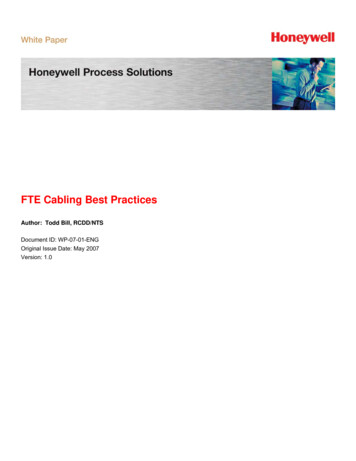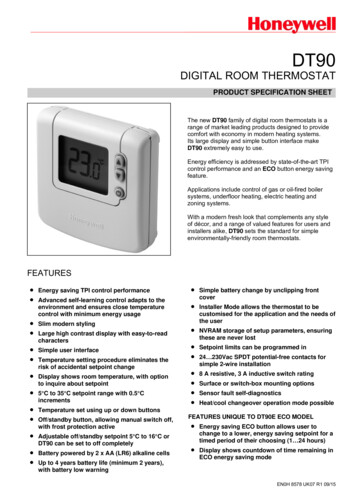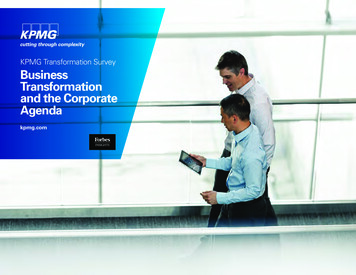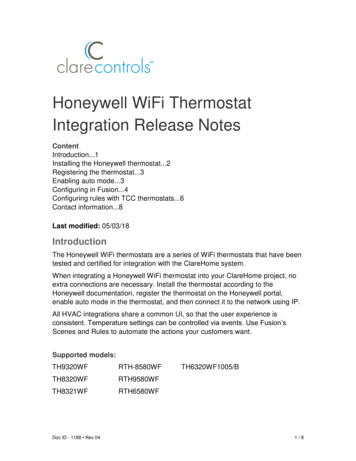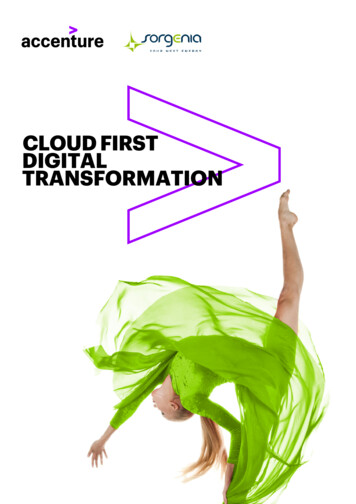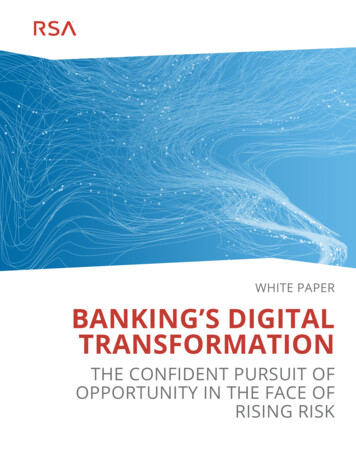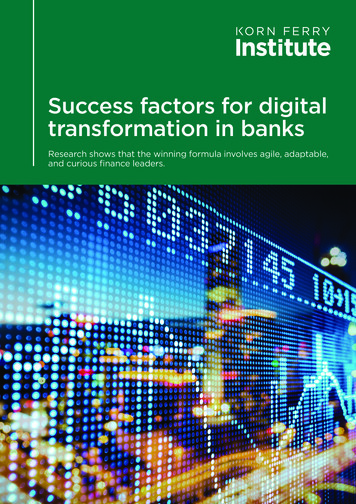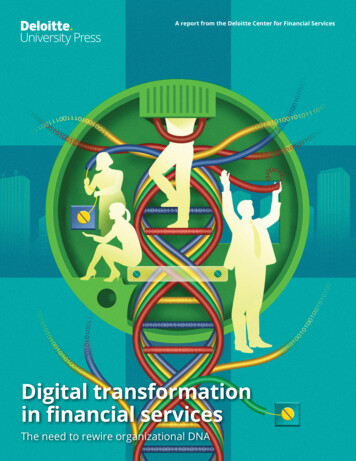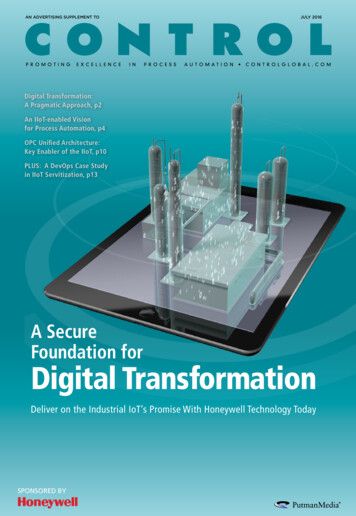
Transcription
AN ADVERTISING SUPPLEMENT TOJULY 2016Digital Transformation:A Pragmatic Approach, p2An IIoT-enabled Visionfor Process Automation, p4OPC Unified Architecture:Key Enabler of the IIoT, p10PLUS: A DevOps Case Studyin IIoT Servitization, p13A SecureFoundation forDigital TransformationDeliver on the Industrial IoT’s Promise With Honeywell Technology TodaySPONSORED BY
INTERVIEWA pragmatic approachto digital transformationHoneywell’s vision for the Industrial Internet of Things builds enterpriseoptimization, ecosystem analytics and domain expertise on a securefoundation of seamless data access and information transparencyHoneywell Process Solutions is no stranger tohelping its process industry clients harness digitalinnovation for business benefit. Indeed, the company’s digital firsts include both the distributedcontrol system (DCS) and the “smart,” digitallycommunicating transmitter. Today, the IndustrialInternet of Things (IIoT) represents only the latest advance in the evolution of digital technologythrough which Honeywell has continuously supported its customers since the 1970s, according toAndrew Hird, vice president and general managerof the company’s newly minted Digital Transformation organization.Honeywell’s approach to the IIoT is a pragmaticone, Hird says. “It’s still all about finding out ourcustomers’ challenges and problems, then applyingtechnology to solve them,” he says. “And while theIIoT can help solve important, previously unsolvable problems, our fundamental approach hasn’tchanged.” CONTROL recently caught up withHird to discuss the IIoT by Honeywell and whythe company is uniquely positioned to help theprocess industries to realize the IIoT’s transformative potential.QAWhat do you see as the essential aspects ofthe IIoT as applied to the process industries?There are three important aspects to the IIoT,and if you get all three right you can extracthuge value. The first is data consolidation. Multiple disparate systems of data have to be broughttogether. Only then can you identify the root causesof problems that simply weren’t visible before.Second, you need to be able to move that data, ina secure fashion, from the plant into enterprise sysS-2 More on the IIoT by Honeywell: www.hwll.co/IIoTtems where you can leverage the advanced analyticsand expertise that exists across the organization.The third essential aspect of the IIoT is the abilityto securely tap the domain expertise of a wholeecosystem of partners in the cloud, where otherorganizations such as process licensors and originalequipment manufacturers [OEMs] can help solveadditional problems. It’s not just about monitoring,it’s about taking that diagnostic knowledge of theOEM and embedding it in an application that canpredict and prevent failure.QAWhat business benefits can processors expectto realize by investing in the IIoT?The IIoT can help solve a range of historically difficult problems. The first has to dowith reducing plant downtime. Most customers Iknow are happy with 88% plant availability. Theyplan to lose 5% on planned shutdowns, and theother 7% “just happens.” So, there’s a big paybackif you can go after this 7%. The second problemwhere the IIoT can help involves staying on spec.Product that doesn’t meet specifications—or an inprocess batch that has to be thrown away—mightrepresent millions in lost revenue for a pharmaceuticals manufacturer. A third key area wherethe IIoT can help business is in the integration ofsupply chains, which run far more efficiently withreal-time visibility among participants.QHoneywell has a long-standing industryleadership position in measurement, controland optimization. How has the company evolvedthe range of its portfolio in order to help clientsrealize the promise of the IIoT?
INTERVIEW“Without rock-solidcyber security, customersare reticent to put dataup into their ownenterprise systems—let alone into the cloud.”– Andrew Hird, Vice President and GeneralManager, Digital Transformation, HoneywellProcess SolutionsAThrough our consistent evolution philosophy,we’ve never left a platform—or a customer—behind. No matter when you bought a controlsystem from Honeywell it can coexist under thecurrent architecture. For example, a TDC 2000customer from 1975 is able to run that technology inside Experion, preserving their intellectualproperty. And because Experion is Ethernet-based,it’s also IIoT-ready. It’s very, very easy to pull datafrom it. Further, the Experion Orion operatorconsole itself is a fantastic device for consolidating data and giving operators the information theyneed to make better decisions.Our IIoT capabilities also are supported byseveral key technologies including Intuition Executive, the platform in which our data models reside.OPC Unified Architecture (UA) allows strandeddata from all sorts of devices to be brought verysecurely and simply back into the DCS, or directlyinto the cloud. The third key enabler is rock-solidcyber security. Without it, customers are reticentto put data up into their own enterprise systems—let alone into the cloud. All the investments we’vemade into making our systems and our customers’networks secure is accelerating the IIoT’s uptake.QYou’ve been tapped to lead the newly formedDigital Transformation business unit withinHoneywell Process Solutions. Can you explainwhy that organization was formed and how youenvision it working to deliver results for yourprocess industry clients?AWe’ve actually been solving these sorts ofproblems for a long time. We’ve collecteddata, we’ve done analytics and we’ve writtenadvanced software applications. What’s differentnow is that we have to do it much more rapidlyand we have to allow our customers to use thesecapabilities in the cloud—to run not only theirindividual sites but their enterprises.We also are focused on developing partners,finding those OEMs and process technology companies that have that depth of domain knowledgeon particular assets and bringing them into theHoneywell ecosystem.QAWhat distinguishes Honeywell’s approachfrom that of other technology suppliers?The process industries need a partner that hasfoundational technologies in process automation and advanced software applications, but alsosecure integration and communication technologies like OPC UA and cyber security. We inventedthe DCS; we own MatrikonOPC; we’ve got themost progressive cyber security organization ofany process automation supplier; and we’ve beenbuilding software for 40 years, particularly aroundadvanced solutions.Our control systems are in 10,000 plantsaround the world, and we’ve already solved manyof these problems for our customers at individualsites. Now we’re solving bigger problems for themby getting data up into the enterprise layer wherethey can optimize not only individual sites butentire businesses. Further, the IIoT by Honeywellis securely bringing that data into the cloud wherewe can bring to bear Honeywell’s expertise as wellas that of a larger ecosystem of process licensorsand OEMs—all to better solve our customers’particular problems and challenges.More on the IIoT by Honeywell: www.hwll.co/IIoT S-3
ARCHITECTUREAn IIoT-enabledvision forprocessautomationAs functionality is securely redistributed across cloud and edge environments, processautomation systems will perform better and be easier to manage and maintain, tooThe Industrial Internet of Things (IIoT), hasthe promise and potential to be the mostinfluential and disruptive influence onautomation since the advent of the microprocessor-based distributed control system (DCS). Earlyarchitectural styles are emerging for the broaderIoT in which ubiquitous sensing is coupled tocloud-borne data analytics and storage systems.While these approaches are certainly viable for abroad-class of IoT solutions—such as for smartgrid and consumer-grade appliances—industrialautomation systems require a more consideredapproach.A fundamental difference is that the IIoT aimsto enhance the operation and management ofindustrial production processes, many of whichinvolve exothermic reactions for which safety is aprimary concern. Security of IIoT-based systemsis also of paramount importance not just from asafety perspective, but also in cases of the production of essential and strategically important goodsand services. This concern results in more stringent security, reliability and availability requirements as well as the ability to continue operationwith intermittent access to Internet resources.When failures do occur, the system must continueoperation where possible or degrade gracefully,deterministically and safely.S-4 More on the IIoT by Honeywell: www.hwll.co/IIoTIntegration with legacy systems a givenAnother distinction of the IIoT is that a factoryor processing plant is a very long-lived, capitalintensive asset requiring long-term support in theface of rapid technological advances. This realityrequires support for existing, ageing equipmentand infrastructure and a means of protectinginvestments in intellectual property. As a result,many devices that will form part of the IIoT willcontinue to communicate via existing, often olderprotocols and will need special mechanisms tointegrate them into the wider IIoT environment.Bringing IoT ideas to the industrial enterprisemeans reconciling and integrating them withexisting automation systems. Indeed, the IIoT is,in spirit, an extension of concepts that Honeywellpioneered in the 1970s with the introduction ofthe Totally Distributed Control system (the TDC2000 distributed control system, or DCS), a precursor to the IoT concept of edge computing. Thelower layers of a DCS tend to be autonomous,with responsibility for the real-time control of theprocess, while the layers above provide various supervisory capabilities including advanced controland human-machine interface (HMI) plus datahistorian and planning and scheduling activities.It is tempting to draw a direct comparisonbetween the DCS of today and the IIoT-based
ARCHITECTUREautomation system of the future and claim thatwe are already doing IIoT, but to do so ignores thesignificant changes to the DCS, as we understandit, that will occur with the introduction of theIIoT. The IIoT arises from the combination of coreDCS concepts such as local, high availability realtime control of industrial processes together withthe technologies and architectures that enable theIoT (Figure 1).Some of the key differences between an IIoTarchitecture and a conventional DCS architecturecan be illustrated by comparing the architecturesat their highest levels (Figure 2). The structure of aDCS and associated applications typically conforms to the well understood Purdue EnterpriseReference Architecture developed in the 1990s.This abstract model typically has a corresponding realization in the topology of the system inwhich boundaries between levels are often expressed as network boundaries across which security can be enforced. The IIoT architecture illustrated in Figure 1 is, at the highest level, separatedinto two major subdivisions—the edge and thecloud. This structure can be further broken downinto the seven-level model shown in Figure 2.Applying an IIoT architecture to an industrialenterprise requires reconciling these two differentorganizational structures so that the key zetectural qualities provided by the Purdue model(safety, security, reliability, efficiency) are maintained and enhanced within an IIoT-based structure. Level 1 of the Purdue model, basic control,moves to the edge in the IoT model, while Level4, business planning and logistics, moves to thecloud. There is also a strong argument for moving much of Level 2, area control, to the edge forperformance, security and reliability reasons. Thefunctionality represented by Level 3, site manufacturing operations, will be split between cloud andedge depending on the balance of key system quality attributes. History, advanced process control,batch and alarm management are all examples offunctions that can be deployed either in the cloud,on premise in embedded devices, or both.Moving functionality to either the cloud or theedge represents a tradeoff amongst a number ofsystem qualities. For example, moving functionality to the edge can improve performance andreliability at the expense of having to provisionand manage functionality distributed across alarge number of devices. On the other hand, moving functionality to the cloud makes it easier toinstall, scale up, upgrade and retire at the expenseof the functionality being remote from the devicesand controllers on which the functionality maydepend. In general, the move to an IIoT-basedEngineeringHMIHoneywell Cloud PlatformCompute and StoreThe CloudInternetThe NetworkThe EdgeEdgeGatewayReal TimeControlEdgeGatewayHMIHMIReal TimeControlSensors,Actuators,ControllersHMIReal TimeControlReal tuators,ControllersFigure 1. The Industrial IoT arises from the combination of core DCS concepts such as local, high availability real-timecontrol of industrial processes together with the technologies and architectures that enable the IoT.More on the IIoT by Honeywell: www.hwll.co/IIoT S-5
ARCHITECTUREEnterprise ZoneEnterprise NetworkLevel 5The CloudCollaboration and ProcessSite business and logistics Level 4networkApplicationDMZDemilitarized Zone –Shared AccessData AbstractionManufacturingZoneSite ManufacturingOperations and ControlLevel 3Area ControlLevel 2Basic ControlLevel 1ConnectivityProcessLevel 0Physical Devices andController ProcessCell/AreaZoneData AccumulationThe EdgeEdge computingFigure 2. The traditional Purdue Enterprise Reference Architecture model (left) compared with Cisco’s Internet of ThingsReference Model (right).architecture will result in a system unconstrainedby the hierarchical structure of a DCS.Improved support for key operational objectivesThe overriding concern in any industrial enterpriseis safety, for which there are
Digital Transformation business unit within Honeywell Process Solutions. Can you explain why that organization was formed and how you envision it working to deliver results for your process industry clients? A We’ve actually been solving these sorts of problems for a long time. We’ve collected data, we’ve done analytics and we’ve written advanced software applications. What’s .
